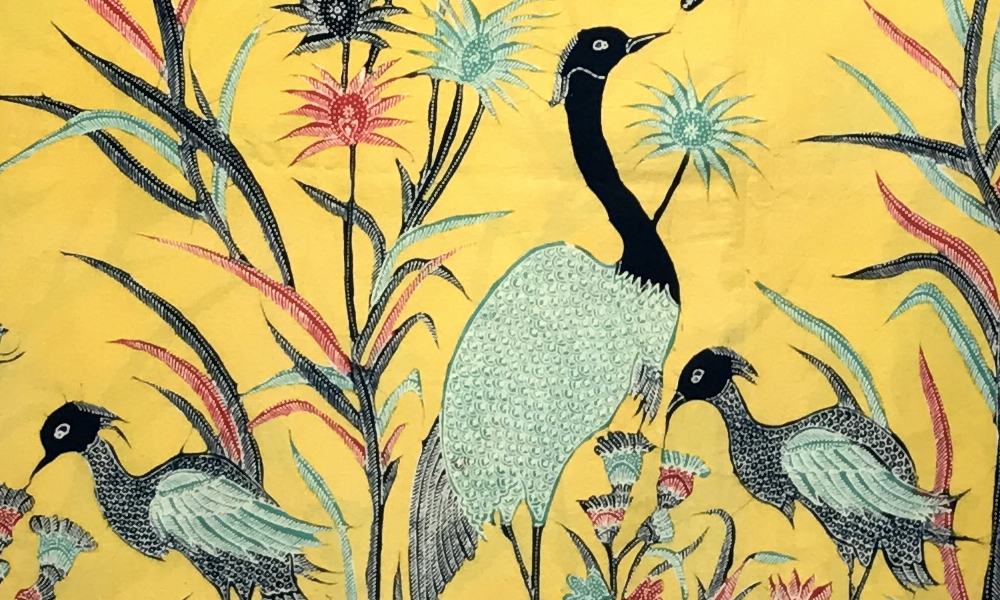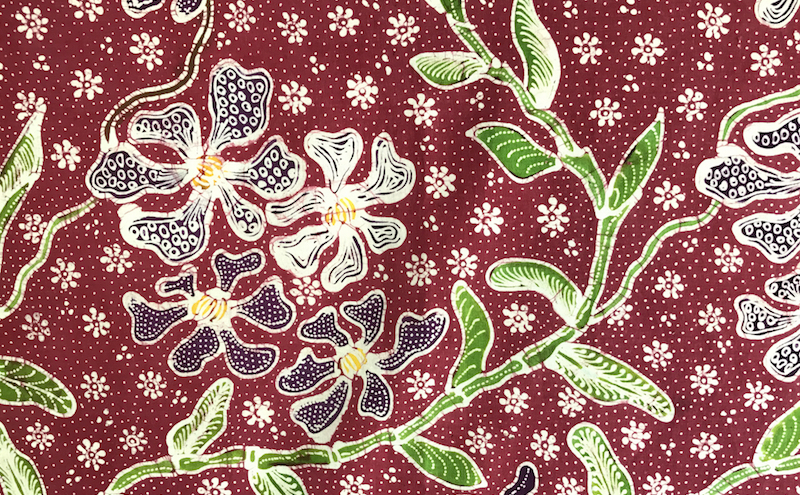Batik Motif: the Art of Philosophy and Science

An example of Batik Pedalaman, featuring Parang and Nitik
Since its discovery in the 17th century, Indonesian batik textile arts may be synonymous with Javanese culture. However, with information and cultural exchange, designs transform into batik motifs with unique individuality that reflects locality, era and belief systems. Let’s take a journey through time and learn about the development in the Indonesian batik motif.
Batik Pedalaman: the Oldest Batik Motif
Batik pedalaman (inland batik) refers to batik motif that is associated with the central of Java under the ruling of Mataram Sultanate. This is allegedly where the development of Batik started in Indonesia.
The distinct features of batik pedalaman are the colour and the abstract design. Inland batik are commonly brown, dark blue and white in colour, reflecting the Hindu Trinity Gods, namely Brahma, Vishnu and Shiva. Despite of the symbolic design, most batik pedalaman motifs are inspired by nature and have deep philosophical meaning. Some notable motifs include the truntum, semen and ayam puger. In a single word, these motifs represent love, strength and prosperity, respectively.
The Royal Affairs of Batik Pedalaman
Some designs were drawn by the royal artists as a blessing to be bestowed upon the royal family members. However, as the demand for textile grew, works were outsourced to batik artisans outside of the royal ground. This caused the royal motifs to be copied and worn by the commoners. As a result, the King passed on a decree that lists all the motifs that are restricted for use within royal ground, for both family members and staff. These motifs are called batik larangan (forbidden batik) and include popular patterns like parang and kawung.
Since the Gianti treaty in 1755, the Mataram Sultanate split into two territories as the Surakarta Sultanate (currently Solo) and Yogyakarta Sultanate. As a result, there was a division on all aspects of administration including “cultural division”. Interestingly, nothing was claimed by anyone. All the forbidden motifs still belong to both royal palaces. Instead, the usage and colour tones are what differentiates the two kingdoms. For example, Surakarta batik has light sogan (brown) background and soft overall colour. On the contrary, Yogyakarta has white background and bold brown motif.
Batik Pesisir: the Colourful Dyeing Affair
The art of batik travelled from the centre towards the northern coastal cities of Java, including Cirebon, Pekalongan and Lasem. Batik pesisir motif often reflects the external cultural influence from the incoming traders and Dutch/European community. Also, due to the introduction of synthetic dyes, batik pesisir became more colourful and it opened up rooms for experimentation.
The Chinese, Indian and Arabic traders brought a vast influence to batik pesisir. Cultural motifs are drawn into local batik masterpieces. Chinese mythical creatures, such as dragons and qilin, are common in batik from Cirebon. Scenery paintings, like Taman Teratai (lotus pond), featuring birds standing in a lotus pond, is a popular motif. The Indians gave rise to the Jelamprang motif from Pekalongan based on the Indian patola textiles. Finally, Arabic traders brought in Islamic-inspired motifs.
Taman Teratai (Lotus Pond), a type of Batik Pesisir
Other than the motif, the uses of these batik motif varies giving rise to a variety of sizes. For example, other than for fashion, these cloths are used for altar cover (i.e. kain tok wi) or home decor.
While batik pedalaman has patterns that are reserved for people with specific position, in batik pesisir, the status of the wearer are often shown by the colour of the cloth. Younger ladies wore light colours whereas the darker colour are reserved for the mature ladies.
Batik Tiga Negeri: the Exclusive Batik Collection
Batik Tiga Negeri, literally translated as Three Kingdom batik is a unique classification of artwork. It is a treasure that combines both the symbolism and details of batik pedalaman and colours and cultural influence of batik pesisir motifs. The three kingdoms refers to the three different places where a single kain panjang piece are dyed. Due to the difference in the pH and mineral content of the water sources, each area is known to produce a signature colour of a superior quality as compared to other batik towns. Solo, Lasem and Pekalongan are best known for their sogan (brown), merah darah ayam (bright red that resembles chicken’s blood) and blue colour, respectively. Known as a travelling batik, a single Batik Tiga Negeri would travel through these three batik towns to be wax-treated and coloured, making it an exquisite prized collection.
Batik Indonesia: Batik Motif Time Capsule
Indonesian batik development can be traced along the historical time journey, starting with the European-influenced motif. Inspired by European magazines and paintings, motifs are literal. Examples include buketan (a bouquet of flowers), butterflies and flowers. Some Dutch batik cloths show paintings of a scenery out of fairytales, like Cinderella and Red Little Riding Hood, or everyday events, such as a war scene (told from the point of view of the Dutch). Adding signature on a batik cloth also started by the Indo-European batik traders due to rampant plagiarism by other producers.
During the Japanese occupation, Japanese design of small flowers motif and oriental wave patterns are common. A notable design is the batik pagi sore (Morning-Evening batik). Due to the shortage of raw cotton, a whole kain panjang has two totally different motifs and colour. This cloth was to be worn once in the morning and flipped over to be worn in the evening. This is popular among the aristocrats’ wives who were embarrassed to be caught wearing the same cloth twice a day. Due to the complexity, the process took longer and, therefore, reducing the number of unemployed population.
Purple orchid, an example of Batik Indonesia
After the World War II, the batik artisans travelled and resided throughout the archipelago, assimilating with the local culture. This is evident in the textile motifs, showing the characteristics of the general population in the region. For example, in Borneo and Papua, the batik features prints of animals and tribal symbols. Sumatran artists incorporate Islam-influenced designs like scriptures and arabesques.
Batik Kontemporer: the Globalization of Batik Motif
Contemporary batik can be roughly defined as any artwork that are produced after the year 2000. Both abstract and realistic, monochrome or colourful, there is no single defining feature of a batik kontemporer. Design depends on the education, values and interest of the individual artist. Each art pieces has their own history. Indonesian artists may receive western art education and international artist incorporates batik into new mediums, such as wood and canvas. The applications of batik vary from wearables to painting and textile art installations. Perhaps, the closest description of a contemporary batik would be as an eclectic mix of international pop culture on a single textile.
A contemporary artwork by a Cirebon artist
Evidently, batik motif transforms with time. It becomes a living cultural artefact which shows the evolution of the fabric of Indonesian society in terms of thoughts, creativity and innovation.




0 Comments